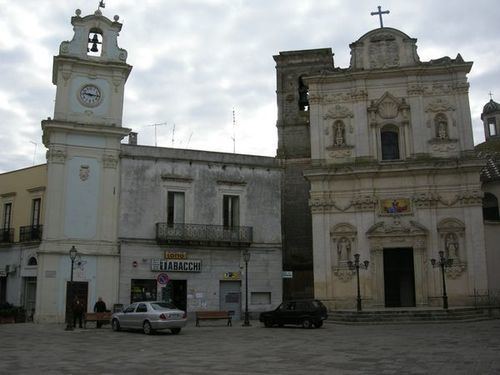Demonym(s) Monteronesi Local time Saturday 3:44 AM | Elevation 35 m (115 ft) Time zone CET (UTC+1) Postal code 73047 | |
 | ||
Weather 9°C, Wind SE at 8 km/h, 82% Humidity Points of interest Apollonio Casa Vinicola, Piazza Padre Pio, Palazzo Baronale | ||
Monteroni di Lecce is a town and comune in the province of Lecce, Apulia, southern Italy town with ca. 13,600 inhabitants. It is 7 kilometres (4 mi) from Lecce, in the area called Salento (reported until recently also as Terra d'Otranto).
Contents
- Map of 73047 Monteroni di Lecce Province of Lecce Italy
- History
- Main sights
- Culture
- Twin towns
- References
Map of 73047 Monteroni di Lecce Province of Lecce, Italy
History
Probably the name Monteroni comes from Latin Mons Tyronum, meaning "mount of the spear-men" and hinting its origin as a training camp for the Roman legions. In fact originally the Romans apparently established a military stronghold on the hill nowadays called San Filii. From this era of romanisation of the region, coins and other archaeological material has been found and studied.
During the Norman period, the fiefdom of Monteroni was part of the County of Lecce. In 1250 Holy Roman Emperor Frederick II (and also sovereign of the Kingdom of Sicily) granted the fiefdom to the De Cremona family, followed in this feudal office by the Montoroni family who held it until the 16th century. The Montoroni built the first Baronial Palace in the town in the original shape of a small fortress.
When the fief passed onto the Duke of Spongano, the Baronial Palace was enlarged and gained the current Leccese Baroque style. Monteroni di Lecce owes the baroque period also its bell tower and the two chapels, which were in the central square (currently “Piazza I. Falconieri”) on the site currently occupied by the major church “Chiesa Matrice”.
Feudalism in the south of Italy was abolished with the events following the French Revolution when also the Kingdom of Naples became a republic and then a Napoleonic kingdom. Since then it was the “Municipality of Monteroni di Lecce” which took over and carried on the sorts of the fief of Monteroni.
Main sights
More contemporary architecture include:
Culture
Monteroni di Lecce's status is that of a university town due to the presence of academic institutions and state-of-the-art university facilities.
